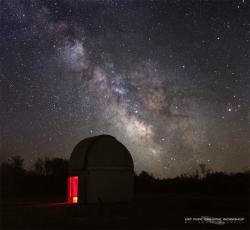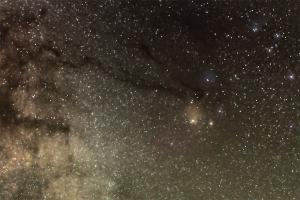
Public Stargazing
- Where:
- Frosty Drew Observatory
- When:
- Friday September 26, 2014 at 7:30 p.m.
- Cost:
- $1 Suggested Donation per Person
Tonight's weather is looking excellent for stargazing! Forecasts are calling for mostly-clear to clear skies all night. The 6% waxing crescent Moon will hang beautifully in the Western sky just after sunset until near 8:00 p.m. offering mystical early Autumn views of the super thin crescent. The Sky Theatre and Observatory will open at 7:30 p.m. On the docket are twilight viewings of Saturn and the crescent Moon. Later in the night Neptune and Uranus will be featured along side an impressive list of nebulae, star clusters, and galaxies. In the Sky Theatre, a slide show of astro-photos taken at Frosty Drew will be on display. Overall, it looks like a killer night to be under the Frosty Drew starscape. Temps will drop into the low 50's overnight, so jackets, long pants, and closed-toe shoes will be essential. If the brisk early Autumn temps are a bit bleak, step into the Sky Theatre and relax in the warm temps while taking in beautiful celestial views.
The rush of Summer is behind us. Get out there New England and get your science on!
-------------------------------------------------------------------------
Weekly Happenings
Scott MacNeill
This weekend we are in for an excellent conjunction of the bright star Antares and Mars. Generally, the prospect of any conjunction in the sky is enough for the average astro-geek to freak out. Though this conjunction will bring an extra prospect of astro-awesome. Since Antares and Mars are so visibly similar, differences in each object will become blurred as they line up for a close pass and most will find it difficult to tell one from the other.
Antares is surely no meager star. It is a bright red supergiant that ranks seventeenth on the list of brightest stars in the night time sky. Found in the constellation Scorpius, the scorpion, Antares lies approximately 550 light years distant from Earth. Being a supergiant, Antares is over 800 times the radius of the Sun. Place Antares where the Sun is today and the outer edge would reach the Asteroid Belt (between the orbits of Mars and Jupiter)! The name “Antares” derives from ancient Greek, meaning “equal-to-ares”. Ares, being the Greek counterpart to the Roman god of war “Mars”, is often considered synonymous with Mars. Antares and Mars look almost identical in appearance which may have been an influencing factor in the naming of Antares.
Get out there this weekend and catch a glimpse of the fantastic conjunction of these two visually striking objects and see if you can tell which is the red planet and which is the red supergiant!
-Scott

